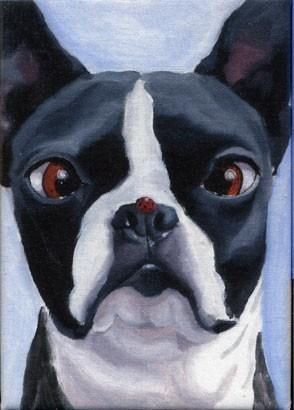
Dog paw pads don’t have the same kind of ridge pattern that human fingertips do, but their noses do, and each dog nose is as unique as a human fingertip. Look at a dog’s rhinarium (the tip of his nose) and you’ll see a tapestry of dimples, dots and ridges. Along with the shape of the dog’s nostril openings, the patterns of lines and creases is never the same between two dogs, and together, they are conclusively enough to identify one dog from others.
From 1938 until April 1992, the Canadian Kennel Club accepted nose prints as a form of unique identification for registration purposes. At that time, both nose prints and tattoo markings were used as a method of identification. As technology evolved, nose prints were phased out and tattoo markings and microchips became the acceptable form of identification. One benefit of moving to tattoos and microchips and away from nose prints, was the important readability factor that supports lost-dog recovery efforts. The unique dog nose prints the club captured for identification were on a 3 x 3 inch piece of regular paper that had serial numbers on it for tracking purposes. Special ink was in the form of an ink pad; the ink pad was pressed against the dog’s nose, and then the 3 x 3 inch paper would be pushed against the dog’s nose to capture the imprint. Cutting edge technology. Because registrations begin was back in 1938, we’re unable to share the breed of the first dog whose nose print was so registered. The CKC tells us that information is all on microfiche, and our guess is that it’s buried under layers of fascinating information
An aside, we figure you already know that with 300 million of them, the Bloodhound has the most number of scent receptors of any in the world – but do you know which breed comes in second?
Right behind the Bloodhound is the German Shepherd Dog and the Beagle, each with 225 million scent receptors. Fox Terriers have 147 million, Dachshunds have 125 million, and we lowly humans are bottom feeders with all of 5 million receptors.
“Boston Terrier with Ladybug on his Nose” by Brian Rubenacker

We need noseprint registries for our pets instead of harmful microchips.
God gave our pets a unique identifier. Yes, their loving noses. Each dog and cat has a nose print as unique as our fingerprints. Todays technology of fingerprint and facial recognition systems could surely be used to track and identify our pets.
So why are they being injected with harmful electronic devices, imbedded in their tissues? Why are people being forced to do this to their pets? Why are we being told these devices are safe, do not hurt out pets or have benefits that exceed the harm?
Ask the $10 Billion medical microchip industry why they promote lies and persist with false advertising to get pet owners to go along. Here are some of the lies:
Big Lie # 1 – A microchip is the size of a grain of rice. Some will say approximately and they will give you a picture, where that is clearly not true. There is a common graphic showing one to be 11.5 mm, but other specifications will give them as 13 mm. Half an inch is 12.7 mm.
Big Lie #2 – A microchip is injected subcutaneously (beneath the skin) and your pet feels little pain. Maybe that was true at one time, but the application was failing due to migration, so the technique was developed for injecting them into the subcutaneous tissues. Multiply that microchip by 20X and implant that in your flesh between YOUR shoulder blades and tell me how good THAT is. Our pets are literally stabbed in the back. Sticking this in a small animal is cruel.
Big Lie #3 – Microchips are passive devices that only activate by a scanner. Yes a scanner will activate them and so will a lot of other electromagnetic waves. So just how much EMF does your pet get zinged with, here? The chip sends a signal of a specific frequency, but the antenna is not a discriminating receiver. Better do an EMF survey of your home and keep your pet away.
Big Lie #4 – The risk of Microchips causing cancer is small. The reporting on tumors is deceptive because all they count are the tumors that grow on the microchips. They need to compare cancer rates in chipped and free animals. What, no data? Or does it just not fit the big money narrative?
Most horrible, because the most frequently reported adverse condition reported, that they cannot dismiss is migration of the chip, they have developed ones that “bond” with your pets connective tissue. And here, I thought it was me that my pet was supposed to bond with.
The application of these devices should be very limited and not normalized for general application. The multinational corporations promoting this are doing animal studies on our pets to build a case to force them on us. They are disengaged freaks and sociopaths. Say no to microchips for pets.
Get more facts: http://www.chipmenot.org.uk/articles/microchipping_lies_legislation_and_lawsuits.html
This is so relevant and important. Thank you for this.